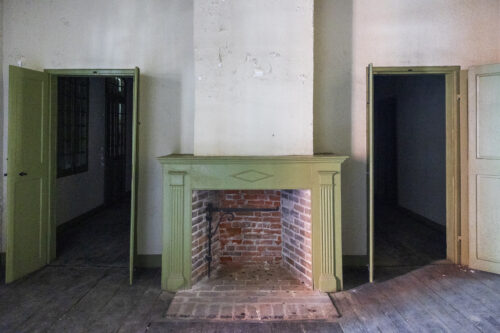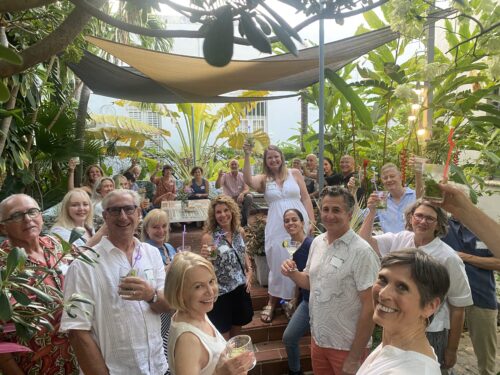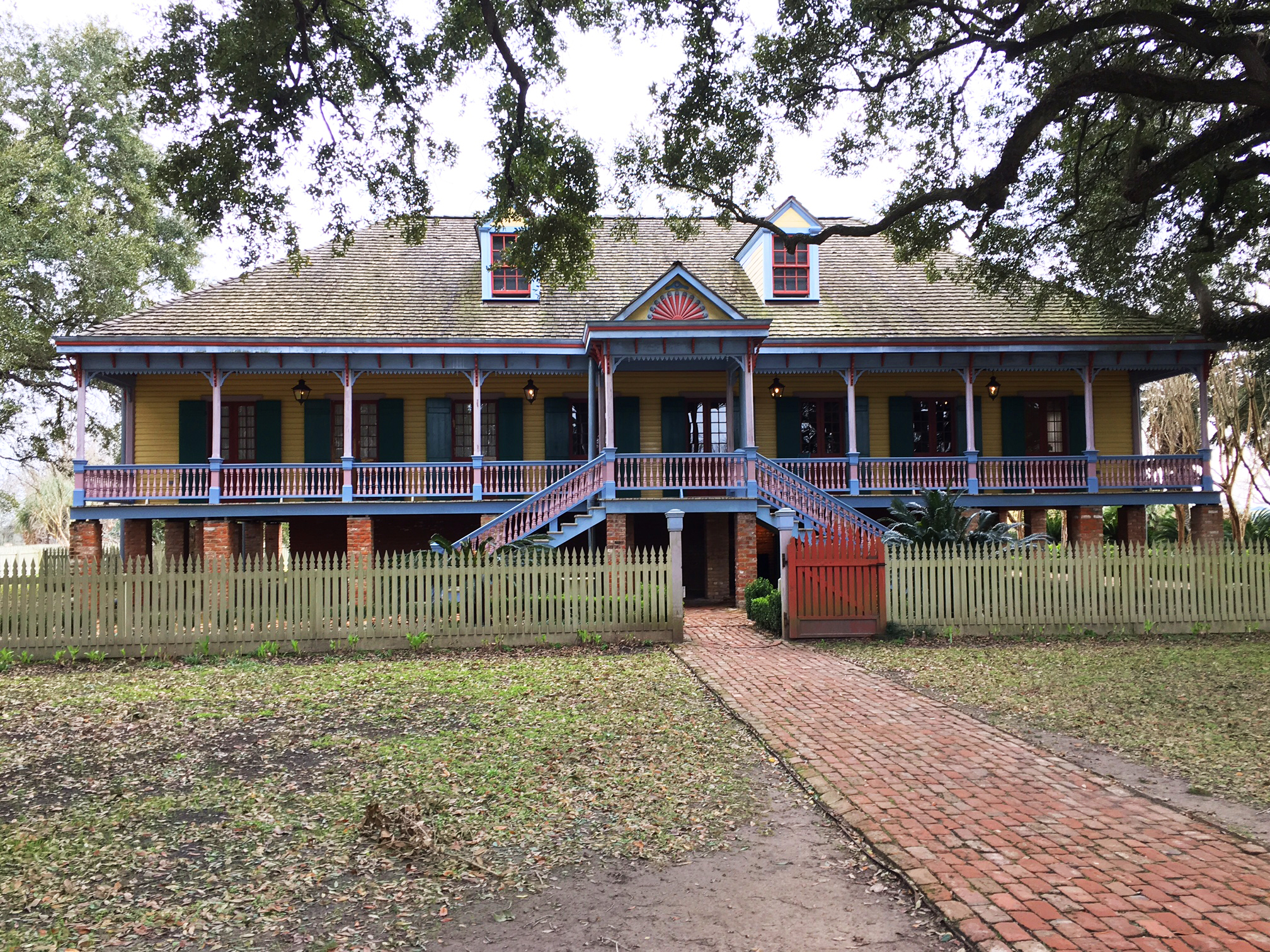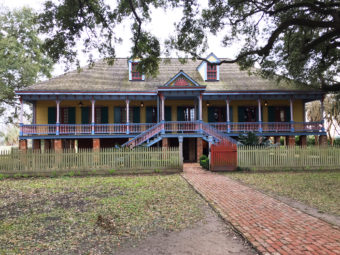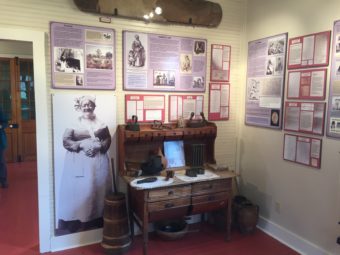After years of research, Laura Plantation in Vacherie has a permanent new exhibit on the history of slavery at the plantation. The exhibit, titled “From the Big House to the Quarters: Slavery on Laura Plantation,” offers a unique, in-depth view of the lives and histories of the enslaved individuals who lived there.
The over-two-century-old sugar plantation on River Road was originally owned by the Duparc and Loucoul families. The site has captivated tour-goers and history-lovers ever since its current owners, Sand and Norman Marmillon, acquired the property in 1993.
The expansive site includes 12 buildings listed on the National Register of Historic Places, with guided tours visiting several different structures vital to the sugar plantation’s operations. The “big house,” hidden from River Road beneath a canopy of live oak trees, is the crowning jewel of the homestead. The building sits high atop a raised basement with a colorfully-painted exterior and a picturesque porch. Other equally important structures on the site include the slave cabins, overseer’s cottages and smaller Creole houses — one of which houses the new exhibit.
- The brightly-painted “big house” sits beneath a canopy of live oak trees.
- Part of the new exhibit at Laura Plantation.
- One of the slave cabins on Laura Plantation.
In modern times, the bucolic setting of historic plantations can present a challenge in confronting and interpreting the harsh realities of slavery — an institution which defined rural life in the South. Until recent years, interpretation of slavery was somewhat swept under the rug at many house museums throughout the South in favor of a more white-washed version of history. Stereotypic imagery of hoop-skirted debutantes sipping sweet tea on front porches has been a perception for plantation house museums to challenge and overcome.
Authenticity has been a high priority for the Marmillons, and Laura Plantation has been at the forefront of slavery interpretation since they acquired the property over 20 years ago. Their research and accumulation of slave documents began shortly after the property was purchased.
Unfortunately, the process wasn’t always smooth sailing. The undertaking has had its fair share of trials and tribulations, including an electrical fire that ravaged the site in 2004. The fire destroyed a large portion of the big house and wreaked havoc on the offices, melting the computers and files containing the Marmillons’ research. After another interruption with Hurricane Katrina and a painstaking three-year renovation of the big house, they picked up the salvageable pieces of their slavery research and continued where they had left off.
Coincidentally, the fire that destroyed much of the plantation brought together Sand Marmillon and historian Katy Shannon, her collaborator on the new exhibit. Shannon came to Laura Plantation in the wake of the fire to offer her assistance. She initially began as Marmillon’s assistant, searching for documents at the notarial archives to uncover the histories of people who were enslaved at Laura. The two eventually worked together to interpret the information they were discovering.
Shannon and Marmillon’s rigorous archive searches led them to individual jigsaw pieces in a very large puzzle. Slave purchase documents, runaway slave advertisements in newspapers, Civil War pension records, and many other documents guided them towards piecing together individual stories. The two began to recognize patterns and connections between the individuals and realized they were looking at a much larger picture.
“We can write whole biographies on some of them, more than I initially ever thought we would,” said Shannon. “At the same time, there are people for whom we just have a sale document. They came here, they worked a little while, and they died.” The exhibit acknowledges the grueling nature of working in the sugarcane fields. The harsh climate, a labor-intensive crop, and rampant disease claimed the lives of many enslaved people brought to the plantation.
Marmillon and Shannon saw their extensive research as an opportunity to create an exhibit unlike other interpretations of slavery at plantation house museums. “Other places you’ll go, you’ll hear a very broad narrative about the slave experience, which is needed,” said Shannon, “but here it’s going to be personal stories of the people who actually lived here.”
Ensuring the individual stories fit into the site-specific context of Laura was vital to the new exhibit. In this sense, the exhibit is very successful. Among the most striking features are the individual slave purchase documents and runaway slave advertisements, which are displayed on the walls in red frames. The vast collage of red frames evokes a sense of the size and scale of the operations at this specific plantation. The documents reiterate the names, photographs, stories and visual descriptions of the specific people affected, which grounds the interpretation with a personalized, humanizing element.
“You hear so much that you can’t really do slavery research and put a name to a face and a story, but you can. It takes years and years of dedication, but that was just our hope.” – Sand Marmillon
Despite the hardships of the oppressive institution of slavery, the persistence of the human spirit prevailed. This theme continued to emerge during Marmillon and Shannon’s research. “We didn’t just want to talk about the brutality of slavery,” Shannon said. “We wanted to talk about the triumph of the human spirit, and how they maintained their dignity and their humanity. They were intelligent people, they were very capable, they succeeded in the midst of [slavery], and formed meaningful relationships.”
Marmillon and Shannon’s unwavering passion for telling these people’s stories is evident. Their years of dedication and research unearthed far more stories than they initially anticipated. With the new exhibit at Laura, they wish to continue to paint an authentic picture of plantation life at Laura. “We hope that we are telling their stories and being true to them, because they lived and they breathed and they are not anonymous, and that was our goal,” Marmillon said. “You hear so much that you can’t really do slavery research and put a name to a face and a story, but you can. It takes years and years of dedication, but that was just our hope.”
Interested in experiencing this new exhibit in person? The PRC is offering a narrated bus tour from New Orleans to Laura Plantation on Saturday, March 18, 2017. The tour includes transportation, a guided tour of the plantation with a special presentation by Sand Marmillon, and a box lunch prepared by a local restaurant. Pre-purchase is required. Buses will leave from the PRC headquarters at 923 Tchoupitoulas Street promptly at 10 a.m.

